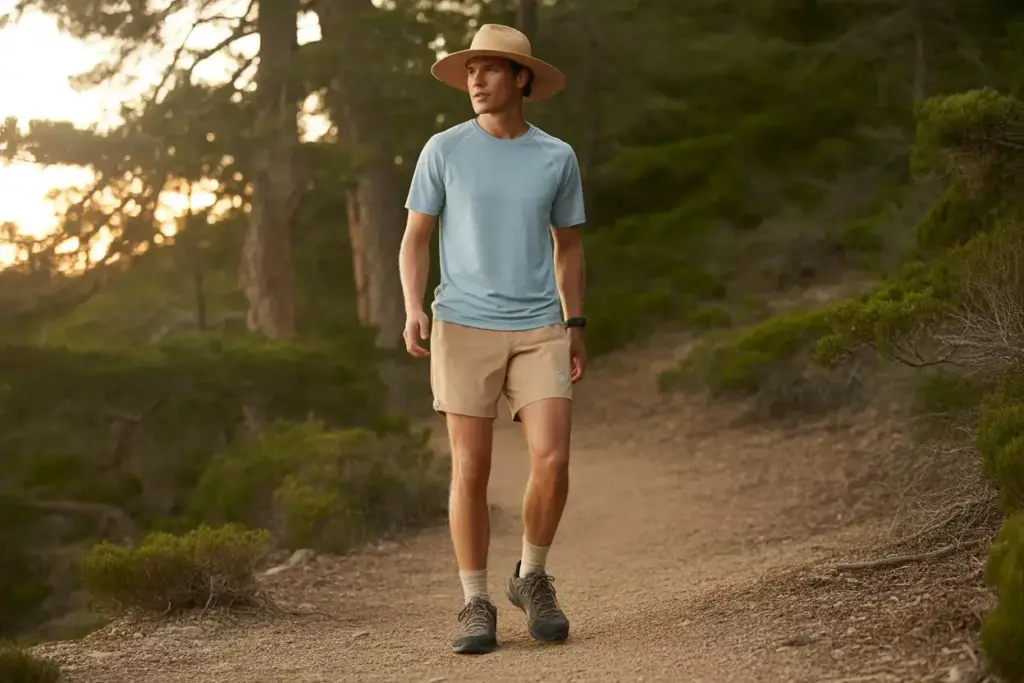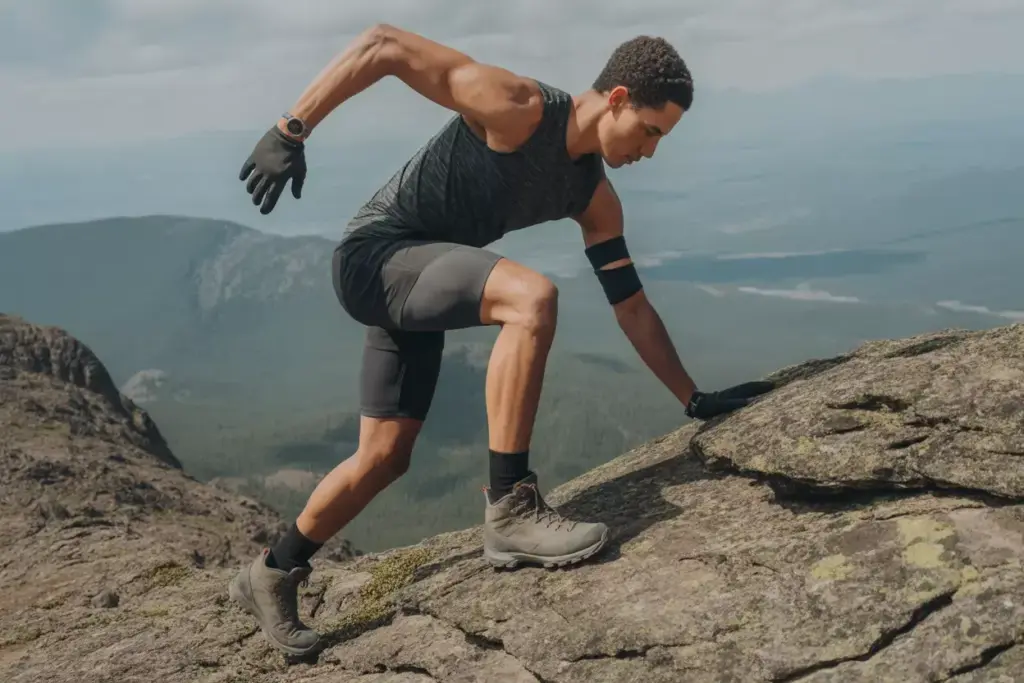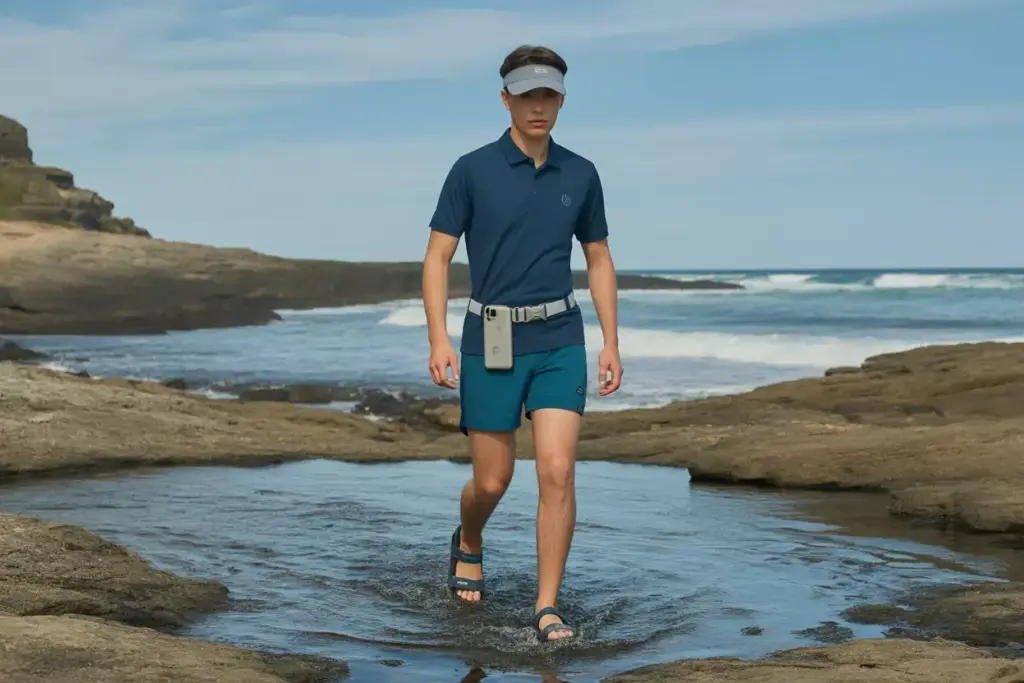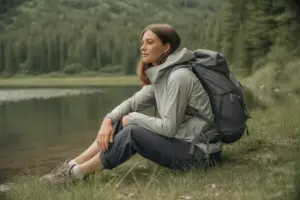7 Breezy & Practical Summer Hiking Outfits for Your Next Adventure
Summer hiking presents a unique challenge: staying cool and comfortable while maintaining protection from the elements. The right outfit can make the difference between an enjoyable trek and a miserable experience under the blazing sun. Whether tackling steep mountain trails or exploring gentle forest paths, these 7 breezy & practical summer hiking outfits will keep adventurers comfortable, protected, and ready for any terrain that lies ahead.
Key Takeaways

- Moisture-wicking fabrics are essential for summer hiking comfort and temperature regulation
- Layering systems allow for quick adjustments as weather and activity levels change throughout the day
- Sun protection through clothing, hats, and accessories is crucial for preventing heat-related illness
- Breathable footwear with proper ventilation prevents overheating and reduces blister formation
- Lightweight materials reduce pack weight while maintaining durability and functionality
Understanding Summer Hiking Clothing Essentials
The Science of Staying Cool 🌡️
Summer hiking demands clothing that works with the body’s natural cooling system rather than against it. Synthetic fabrics like polyester and nylon excel at wicking moisture away from skin, while merino wool provides natural odor resistance and temperature regulation. Cotton, despite its comfort in everyday wear, retains moisture and loses insulating properties when wet, making it unsuitable for serious hiking.
Key fabric technologies to look for:
- Moisture-wicking synthetic blends
- UPF-rated sun protection fabrics
- Quick-dry materials
- Antimicrobial treatments
- Ventilation panels and mesh inserts
Essential Components for Summer Comfort
Every effective summer hiking outfit includes several core elements that work together to maintain comfort and safety. Base layers form the foundation, directly managing moisture and temperature against the skin. Outer layers provide protection from sun, wind, and unexpected weather changes. Accessories like hats, sunglasses, and gaiters add targeted protection for vulnerable areas.
“The best summer hiking outfit is one you forget you’re wearing – it should feel like a second skin that keeps you cool, dry, and protected without restricting movement.” – Trail Magazine
Complete Summer Hiking Outfit Combinations
Outfit 1: The Classic Day Hiker 🥾

Top: Lightweight merino wool or synthetic blend t-shirt in light colors
Bottom: Quick-dry hiking shorts with 5-7 inch inseam
Footwear: Low-cut hiking shoes with mesh panels
Accessories: Wide-brimmed sun hat, lightweight hiking socks, sunglasses
This timeless combination works perfectly for moderate day hikes in temperatures between 70-85°F. The breathable t-shirt provides comfort without bulk, while quick-dry shorts offer freedom of movement and rapid moisture evaporation. Light-colored clothing reflects heat, keeping body temperature lower throughout the hike.
Best for: Day hikes under 10 miles, well-maintained trails, moderate temperatures
Outfit 2: The Desert Explorer 🌵

Top: Long-sleeve UPF 50+ shirt in light tan or white
Bottom: Lightweight hiking pants with zip-off legs
Footwear: Ventilated hiking boots with gaiters
Accessories: Neck gaiter, wide-brimmed hat with chin strap, cooling towel
Desert environments require maximum sun protection while maintaining breathability. Long sleeves might seem counterintuitive, but they prevent sunburn and reduce water loss through perspiration. Convertible pants allow quick adaptation as temperatures change from dawn to midday.
Best for: Desert hiking, exposed terrain, high UV environments, temperatures above 85°F
Outfit 3: The Mountain Scrambler ⛰️

Top: Sleeveless moisture-wicking tank top
Bottom: Stretchy hiking shorts with built-in liner
Footwear: Lightweight hiking boots with ankle support
Accessories: Baseball cap, arm sleeves (removable), lightweight gloves
Mountain terrain demands unrestricted movement for scrambling over rocks and navigating technical sections. The sleeveless design maximizes cooling while stretchy shorts provide flexibility for high steps and challenging moves. Removable arm sleeves offer sun protection when needed without permanent bulk.
Best for: Technical day hikes, rock scrambling, steep terrain, variable weather
Outfit 4: The Forest Wanderer 🌲

Top: Lightweight long-sleeve shirt with insect protection
Bottom: Mid-length hiking shorts (7-9 inch inseam)
Footwear: Trail runners with good traction
Accessories: Lightweight cap, insect head net (packable), moisture-wicking bandana
Forest hiking often involves insect encounters and variable shade conditions. Insect-repelling fabrics or treatments provide protection without chemical sprays, while longer shorts protect thighs from brush and thorns. Trail runners offer comfort on softer forest floors while maintaining breathability.
Best for: Forested trails, humid conditions, insect-heavy environments, moderate distances
Outfit 5: The Coastal Trekker 🌊

Top: Quick-dry polo shirt with UPF protection
Bottom: Board shorts or quick-dry hiking shorts
Footwear: Amphibious hiking sandals or water shoes
Accessories: Visor or cap, reef-safe sunscreen, waterproof phone case
Coastal hiking presents unique challenges with salt air, sand, and potential water crossings. Quick-dry materials handle unexpected splashes, while UPF-rated clothing protects against reflected UV rays from water and sand. Amphibious footwear transitions seamlessly between dry trails and wet conditions.
Best for: Coastal trails, beach hiking, stream crossings, high humidity
Outfit 6: The Alpine Adventurer 🏔️

Top: Merino wool base layer with zip-neck design
Bottom: Lightweight hiking tights or leggings
Footwear: Mid-cut hiking boots with breathable membrane
Accessories: Sun hat, lightweight fleece (packable), UV-protective lip balm
High-altitude summer hiking requires layering flexibility as temperatures can vary dramatically with elevation and weather changes. Merino wool provides excellent temperature regulation, while hiking tights offer muscle support and protection from alpine sun. The zip-neck design allows quick ventilation adjustments.
Best for: High-altitude hiking, variable weather, long distances, early season conditions
Outfit 7: The Ultralight Minimalist 🎒

Top: Ultralight synthetic t-shirt (under 3 oz)
Bottom: Minimal hiking shorts with built-in brief
Footwear: Lightweight trail runners (under 10 oz per shoe)
Accessories: Lightweight cap, minimalist sunglasses, multi-use buff
For weight-conscious hikers tackling long distances, every ounce matters. This outfit prioritizes minimal weight while maintaining essential protection and comfort. Ultralight materials and multi-use accessories reduce pack weight without sacrificing functionality.
Best for: Thru-hiking, ultralight backpacking, long distances, experienced hikers
Essential Accessories for Summer Hiking Success
Sun Protection Arsenal ☀️
Wide-brimmed hats provide crucial shade for face, neck, and ears – areas often missed by sunscreen application. Look for hats with UPF ratings of 50+ and chin straps to prevent loss in windy conditions. Neck gaiters offer additional protection and can double as cooling devices when dampened with water.
Sunglasses should provide 100% UV protection and feature wraparound designs to prevent side glare. Polarized lenses reduce glare from water and snow, while photochromic options adjust automatically to changing light conditions.
Footwear and Sock Systems 👟
Summer hiking footwear must balance protection, breathability, and comfort. Mesh panels in hiking shoes provide ventilation, while moisture-wicking sock materials prevent blisters and hot spots. Consider sock liner systems for longer hikes to reduce friction and improve moisture management.
Gaiters protect against debris, insects, and sunburn on exposed lower legs. Lightweight options made from breathable fabrics won’t add significant weight while providing valuable protection.
Hydration and Cooling Accessories 💧
Insulated water bottles keep drinks cool throughout the day, while hydration packs provide hands-free drinking during active hiking. Cooling towels activated with water provide instant relief during rest breaks, and electrolyte supplements help maintain proper mineral balance in hot conditions.
Fabric Technology and Material Selection
Advanced Synthetic Materials
Modern synthetic fabrics offer superior performance for summer hiking through engineered fiber structures that maximize airflow and moisture transport. Polyester blends with elastane provide stretch and recovery, while nylon ripstop offers durability without weight penalties.
Key technologies include:
- Coolmax fibers for enhanced moisture wicking
- Supplex nylon for cotton-like comfort with synthetic performance
- Tencel blends for natural antimicrobial properties
- Polygiene treatments for odor control
Natural Fiber Advantages
Merino wool remains the gold standard for natural performance fibers, offering temperature regulation, odor resistance, and UV protection in a renewable material. Bamboo blends provide similar benefits with enhanced softness, while hemp fabrics offer durability and natural antimicrobial properties.
Seasonal Considerations and Regional Adaptations
Early Summer Strategies
Late spring and early summer often feature unpredictable weather patterns requiring adaptable outfit choices. Layering systems become crucial as morning temperatures may be cool while afternoon conditions turn hot. Convertible clothing options provide maximum flexibility without carrying extra gear.
Peak Summer Adaptations
Mid-summer hiking in peak heat requires maximum breathability and sun protection. Light colors reflect heat, while loose-fitting cuts promote air circulation. Pre-cooling strategies like dampening clothing before starting can provide initial temperature relief.
Regional Climate Considerations
Humid environments require enhanced moisture-wicking capabilities and antimicrobial treatments to prevent odor buildup. Arid climates demand maximum sun protection and moisture retention strategies. Coastal regions need salt-resistant materials and quick-dry capabilities.
Safety Considerations for Summer Hiking Attire
Heat-Related Illness Prevention
Proper clothing selection plays a crucial role in preventing heat exhaustion and heat stroke. Light-colored, loose-fitting clothing reflects heat and promotes air circulation, while moisture-wicking materials support the body’s natural cooling mechanisms.
Warning signs to watch for:
- Excessive sweating or sudden stop in sweating
- Dizziness or lightheadedness
- Nausea or vomiting
- Rapid heartbeat
- High body temperature
Emergency Preparedness
Summer hiking outfits should include emergency signaling capabilities through bright colors or reflective elements. Whistle attachments and emergency shelter materials like space blankets can be integrated into clothing systems without significant weight penalties.
Budget-Friendly Options and Alternatives
Building a Summer Hiking Wardrobe on a Budget
Quality summer hiking clothing doesn’t require breaking the bank. Synthetic athletic wear from mainstream retailers often provides similar performance to specialized outdoor brands at fraction of the cost. End-of-season sales and outlet stores offer opportunities to acquire premium gear at reduced prices.
Budget-friendly alternatives:
- Athletic department polyester shirts instead of branded hiking tops
- Running shorts with liners instead of specialized hiking shorts
- Trail running shoes instead of hiking boots for easier terrain
- Baseball caps instead of expensive sun hats for basic protection
Investment Priorities
When building a summer hiking wardrobe with limited funds, prioritize items that directly impact safety and comfort. Quality footwear prevents injuries and blisters, while sun protection prevents serious health consequences. Base layers that touch skin should prioritize moisture-wicking properties over brand names.
Maintenance and Care for Summer Hiking Gear
Extending Clothing Lifespan
Proper care significantly extends the life of technical hiking clothing. Cold water washing preserves fabric treatments and prevents shrinkage, while air drying maintains elasticity and prevents heat damage. Specialized detergents designed for technical fabrics help maintain moisture-wicking properties.
Care tips for longevity:
- Turn garments inside out before washing
- Use gentle cycles and cold water
- Avoid fabric softeners that can clog fabric pores
- Store in cool, dry locations away from direct sunlight
- Repair small tears immediately to prevent larger damage
Restoring Performance Features
Over time, DWR (Durable Water Repellent) treatments may require refreshing through specialized products or heat activation. Antimicrobial treatments can be restored through specific washing procedures, while UV protection typically remains stable throughout the garment’s lifespan.
Conclusion
The 7 breezy & practical summer hiking outfits presented here offer comprehensive solutions for staying comfortable, protected, and stylish during warm-weather adventures. From the classic day hiker ensemble to specialized desert and alpine configurations, each outfit addresses specific challenges while maintaining the core principles of breathability, sun protection, and moisture management.
Success in summer hiking depends on understanding how clothing works with the body’s natural cooling systems and selecting appropriate materials for specific environments and activities. Investment in quality base layers, proper footwear, and effective sun protection pays dividends in comfort and safety throughout the hiking season.
Take action today by evaluating current hiking wardrobes against these guidelines and identifying areas for improvement. Start with one complete outfit that matches typical hiking conditions, then gradually expand options for different environments and activities. Remember that the best hiking outfit is one that disappears into the background, allowing focus on the trail, scenery, and pure joy of outdoor exploration.
Plan the next summer adventure with confidence, knowing that proper clothing selection will enhance every step of the journey. The trails are waiting – gear up appropriately and embrace the freedom that comes with perfectly chosen summer hiking attire.




